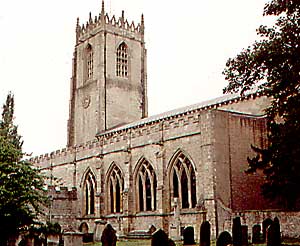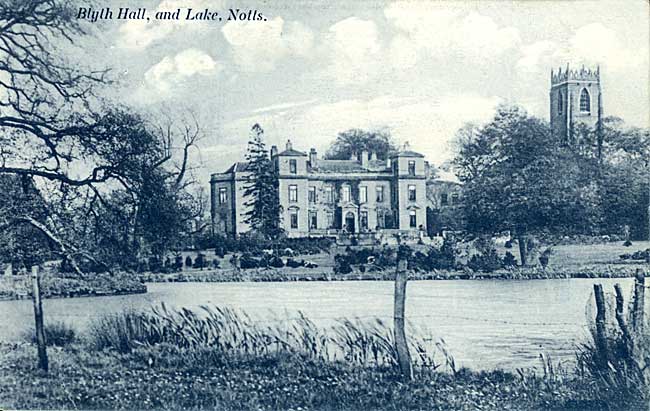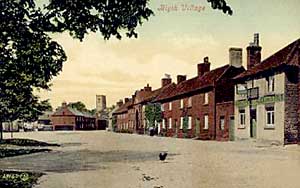Blyth has preserved many ancient charms
IN 1335 one of the hermits of Blyth set men to work upon making a causeway over the marshes to Mattersey, having been empowered to beg money to defray the cost, and thus the existing road thither originated. The priory appropriated the rectory, taking nearly the whole of its income and leaving little for the vicar, and the nave of the church was widened to serve as the parish church, the monks reserving the chancel. In 1349 came the Black Death, the prior being one of its victims, and the plague ushered in a long period of disorder and crime. Outlawries were numerous and in 1352 Robert de Morton of Blyth obtained pardon for abetting and maintaining other outlaws, while a little later the Abbot of Penrith was here waylaid and relieved of his coffers containing £1,000. For about a century lawlessness was rampant, and in 1443 a commission was appointed "to deliver the gaol at Nottingham of certain men of Blyth, monks, gentry, and others" accused of various offences.
Henry IV, who severed the priory connection with Rouen, was here with his army in 1403 after the battle of Shrewsbury, and again in 1405 after crushing the northern rebellion in which the Abbot of Welbeck, Lord Bardolph, the Earl of Nottingham and others of the district were implicated. During the Wars of the Roses the local roads were often crowded with troops, mostly Yorkist, for Nottingham was the central stronghold of Edward IV and Richard III, and in 1471 Sir Gervase Clifton, lord of Hodsock, who had large interests here, was one of the Lancastrians beheaded after the battle of Tewkesbury.
The Priory.

Blyth church.
The priory was an early victim of the Dissolution, being suppressed under mysterious circumstances in 1535. It was grantepl to two speculators who immediately sold it and after passing through the Stanfields and Stanhopes was acquired by Robert Saunderson in 1603, in which year James I, coming south to ascend the English throne, was met at the county boundary in Bawtry by the Sheriff who ''gallantly appointed with horse and man, conducted his Majestie on till he came within a mile of Blyth where his Highnesse lighted and sat down on a bank side to eate and drinke." The manor similarly passed through jobbers and was purchased in 1610 by Sir Gervase Clifton, whose family had owned property here from the 14th century. In 1635 Wm. Saunderson sold his estate at Blyth to John Mellish and seven years later the district was disturbed by the Civil War.
Mellish, being non-resident, leased the estate to its late owner, who sublet it to Colonel Haley, a cavalier who present denounced its proprietor as a rebel and secured the property for himself despite the attempts of Saunderson to forestall him by pleading that his son had fallen in the king's service and begging that it might be returned to him. In 1646, when the war closed, the property reverted to its rightful owner, and Saunderson had to pay a heavy fine to save his own estate, for which he was nominally acting as guardian on behalf of his little grandson. Troops were constantly passing over the local roads, levying contributions as they moved; Welbeck and Tickhill were captured by the Parliamentary army, and in 1644 the Earl of Manchester held an important council of war here, at which decisions were reached which favourably affected the strategy of the war. In 1645, when the royal cause was reeling to its fall a royalist army lay between Welbeck and Blyth, watched by enemy troops, but it marched to Doncaster, and no battle occurred at Blyth.
Quaker persecution.
In 1650 it was reported that Henry Priest, the vicar, was "too weak a man for so great a congregation," but "as he had been instituted in 1634 he was perhaps suspected of royalism. His successor, after being prosecuted for not using the Prayer Book in 1661, conformed in the following year, and so retained the living. In 1672 the school-house was being used for Presbyterian services, but the Indulgence which permitted that was soon withdrawn. Four years later it was returned that there were 227 persons in Blyth of age to taka Sacrament, but 12 disregarded the law by habitually refraining from the Communion. A bitter persecution was then being suffered by the Quakers, one of whom, John Seaton, was mulcted in fines amounting to £348 18s. 8d. for permitting meetings at his house. Others were heavily fined and endured crushing distraints.
One gang of informers, finding one person short of the penal number and all silent, created an offence by sending in a confederate who exclaimed: "Blessed are the peacemakers," but Mr. Justice Sandys, of Scrooby, to whom these Quakers were haled, detected the fraud, and discharged them, though he did not punish the impostors, and at the Sessions when another victim proved that he was 60 miles distant from the village at a time when he was alleged to attend a proscribed meeting, Justice Whalley abused the jury who acquitted him, and told them they deserved to be hanged ! Under the Toleration Act of 1689 the Quakers established a meeting-house which in Victorian times became a Primitive Methodist chapel.

Blyth Hall, c.1905. The hall was demolished in 1973 and the site is now occupied by a housing estate.
Part of the monastic buildings survived in more or less habitable state, but in 1684 they were demolished, a fine new hall was built, and the Mellishes made it their chief seat. It still exists and with its gardens has been greatly admired by distinguished visitors.
In the time of George II there were 218 families in the parish, among whom were eight Papists, eight Quakers, one Anabaptist and one Independent, the Quakers and Anabaptists each possessing a chapel for neighbouring worshippers. Various charities were in operation and in addition to two hospitals or almshouses there was a school endowed with £5 a year in which ten children received free education. The Jacobites of 1745 disturbed the quiet of the village and it was feared that they would come hither. On December 4th scouts reported that "Bonnie Prince Charlie" was in retreat, and on the 7th the Royal Hunters, pausing here on their way to join Gen. Wade at Doncaster confirmed the tidings, and the village, whose prosperity had long been on the wane relapsed into its usual routine.
One of the Bucks.
Enclosures had been made by 1700 and under George II William Mellish improved his estate and the amenities of the neighbourhood by laying out ten miles of public roads, cutting a river four miles long to drain marshy land, building farmhouses and cottages, and "beautifying" the Hall to which he added extensive stabling. He also constructed the handsome bridge on the high road near the church and established various plantations, and his son continued the policy by planting between 300 and 400a. mostly of firs, giving the demesne a forest-like charm. His grandson was the last of his line to own this property, which he lost by extravagance. Living in magnificent style as one of the most famous sportsmen of the day, and forming one of the wastrel Court of the Prince Regent, he maintained a large racing stud and was an inveterate gamester of whom strange stories are related, once losing, it is said, £40,000 upon a single throw of the dice. In 1806 he sold Blyth to Mr. Joshua Walker, founder of the Masboro Iron Works and retired to his estate at Hodsock, subsequently serving as one of Wellington's aides-de-camp and serving with distinction in the Peninsular War. He died in 1817 in high repute, having been no one's enemy but his own.

A view along High Street, Blyth, c.1910.
About 1814 a further enclosure was made and the village assumed much of its present appearance. Its market had recently been given up but sixteen coaches passed through daily. When Nottingham Castle was burnt down in 1832 its owner, the Duke of Newcastle, fortified and garrisoned Clumber, and here he held conference with the military commander for local defence—but the rioters did not venture in this direction". From that time onwards Blyth has pursued "the noiseless tenour of its way,'' occasional plagues of cookchafers being the chief disturbers of its peace, the most outstanding event being the severance of Bawtry and Austerfield from the vicarage and parish, in 1858. Two years later its vicar, the Rev. John Raine, published his fine history, and in 1885 its noble church was carefully restored. Modern progress has not marred the local charm, which has been enhanced by the creation of its wide and picturesque main street through the removal of a row of dilapidated cottages, and the Blyth of today deserves the enconium of a recent writer who described it as "old and lovely, one of the most gracious villages in Notts."
